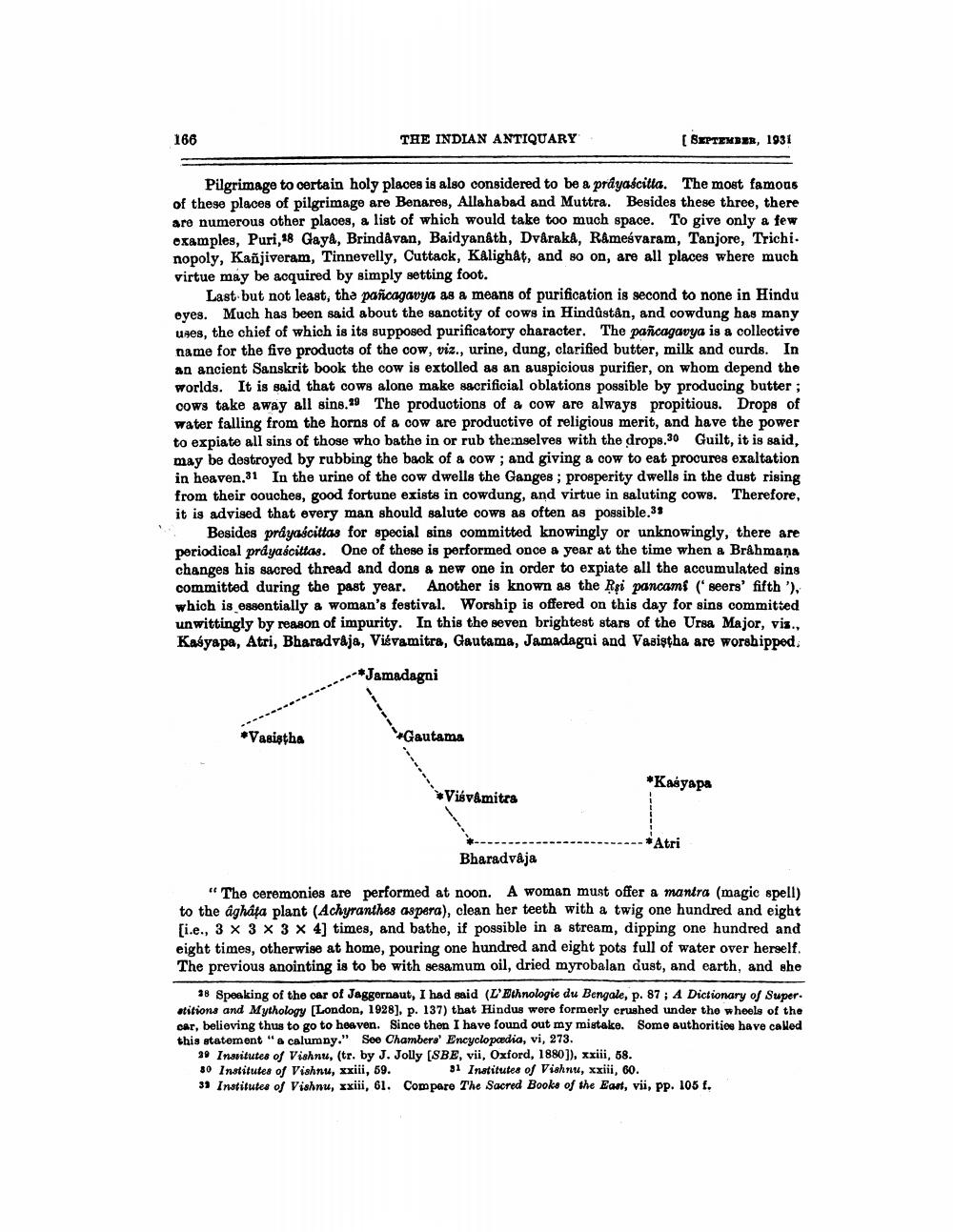________________
166
THE INDIAN ANTIQUARY
[ SEPTEMBER, 1931
Pilgrimage to certain holy places is also considered to be a prdyascitia. The most famous of these places of pilgrimage are Benares, Allahabad and Muttra. Besides these three, there are numerous other places, a list of which would take too much space. To give only a few oxamples, Puri, 18 Gaya, Brindavan, Baidyanath, Dvåraka, Ramesvaram, Tanjore, Trichi. nopoly, Kañjiveram, Tinnevelly, Cuttack, Kalighat, and so on, are all places where much virtue may be acquired by simply setting foot.
Last but not least, the pañcagavya as a means of purification is second to none in Hindu eyes. Much has been said about the sanctity of cows in Hindústân, and cowdung has many uses, the chief of which is its supposed purificatory character. The pañcagavya is a collective name for the five products of the cow, viz., urine, dung, clarified butter, milk and curds. In an ancient Sanskrit book the cow is extolled as an auspicious purifier, on whom depend the worlds. It is said that cows alone make sacrificial oblations possible by producing butter; cows take away all sins.49 The productions of a cow are always propitious. Drops of water falling from the horns of a cow are productive of religious merit, and have the power to expiate all sins of those who bathe in or rub themselves with the drops.30 Guilt, it is said, may be destroyed by rubbing the back of a cow; and giving a cow to eat procures exaltation in heaven.31 In the urine of the cow dwells the Ganges ; prosperity dwells in the dust rising from their couches, good fortune exists in cowdung, and virtue in saluting cows. Therefore, it is advised that every man should salute cows as often as possible.38
Besides prayascittas for special sins committed knowingly or unknowingly, there are periodical prdyascittas. One of these is performed once a year at the time when a Brahmana changes his sacred thread and dons a new one in order to expiate all the accumulated sins committed during the past year. Another is known as the Rsi pancamí (seers' fifth '). which is essentially a woman's festival. Worship is offered on this day for sins committed unwittingly by reason of impurity. In this the seven brightest stars of the Ursa Major, vis., Kasyapa, Atri, Bharadvája, Viévamitra, Gautama, Jamadagni and Vasistha are worshipped.
----*Jamadagni
*Vasistha
*Gautama
*Kasyapa
Visvamitra
------- *Atri
Bharadvaja
"The ceremonies are performed at noon. A woman must offer a mantra (magic spell) to the ágháfa plant (Achyranthes aspera), clean her teeth with a twig one hundred and eight [i.e., 3 X 3 X 3 X 4) times, and bathe, if possible in a stream, dipping one hundred and eight times, otherwise at home, pouring one hundred and eight pots full of water over herself. The previous anointing is to be with sesamum oil, dried myrobalan dust, and earth, and she
38 Speaking of the car of Jaggernaut, I had said (L'Ethnologie du Bengale, p. 87; A Dictionary of Super. atitions and Mythology (London, 1928), p. 137) that Hindus were formerly crushed under the wheels of the car, believing thus to go to heaven. Since then I have found out my mistake. Some authorities have called this statement "a calumny." See Chambers' Encyclopaedia, vi, 273.
39 Inavitutes of Vishnu, (tr. by J. Jolly (SBE, vii, Oxford, 1880]), xxiii, 58. 80 Institutes of Vishnu, xxiii, 59.
1 Institutes of Vishnu, xxiii, 60. 31 Institutes of Vishnu, xxiii, 61. Compare The Sacred Books of the East, vii, pp. 105 f.




